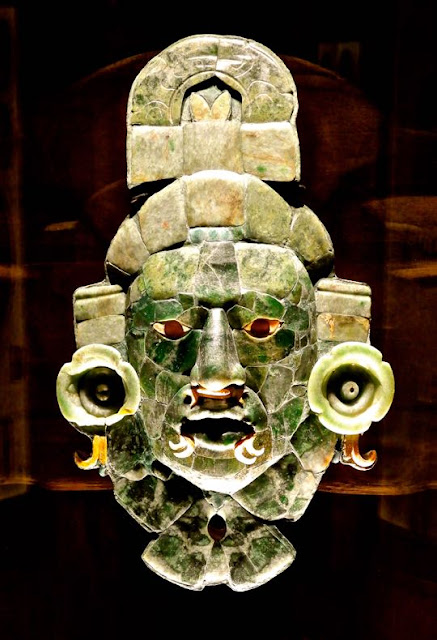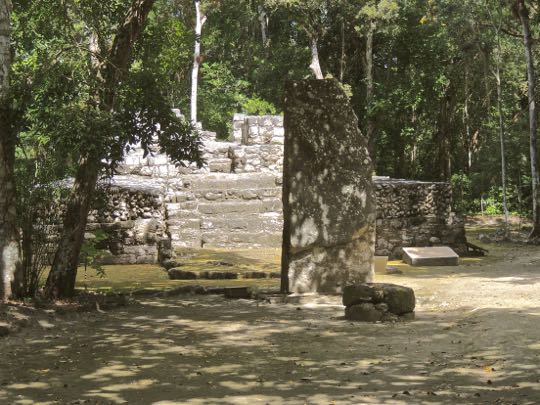In previous postings of this series, we looked at the great pyramid called Structure II that forms the south end of the Gran Plaza. This time, we'll focus on the structures on the north end, and take a look at an important tomb and one of their monuments called Stela 1. Like Structure II, the ways in which these buildings were used changed over time to include political and residential functions, in addition to the original religious purposes. (Photo by Oleg Chernyshov, Flikr)
The top of Structure VII peeks through the jungle canopy. From the Plaza level to the top is 24m (79ft). The pyramid used to be even taller, because in ancient times the temple on top was capped with a tall roof comb. This was a rectangular lattice framework with stucco decorations, a very popular Classic Maya architectural feature. However, even with its roof comb, this pyramid would have been dwarfed by Structure II, which tops out a 55m (180ft).
The aptly-named "Mask of Calakmul"was found in Tomb 1. This is the most elaborate, beautifully-crafted mask so far discovered at Calakmul. It is a mosaic of jade, with large jade ear spools framing the face. The pupils of the eyes are made from obsidian and the whites from conch shell. The curving objects in the corners of the lips are canine fangs. Every part of the mask carries deep meaning.
Jade jewelry found in Tomb 1. The individual in the crypt wore a heavy, multi-strand necklace around his neck, as well as a large pendant called a scapula. He also wore bracelets on both wrists, a large ring on his right hand, and jewelry on his knees, all of jade. More jade, in the form of beads, was woven into his clothing.
Stela 1 stands in front of Structure VIII. The round disk in front of the stela is an altar. Most of the text on the stela is illegible due to weathering. However, three pieces of information remain: Ux te' tuum (Calakmul's ancient name), the title kaloomte' (overlord), and 721 AD, the stela's erection date. This actually tells us quite a lot.
The Gran Plaza is central to the rest of Calakmul. Structure VII is at the top (north) end of the Plaza. Moving clock-wise, Structure VIII is the small temple to its right. The east side of the Plaza is defined by a long rectangular platform topped by three temples called Structure IV.
Separating Structure II (at the bottom) from the rest of the Plaza is Structure V, which is surrounded by ten stelae. On the west side of the Plaza stands Structure VI which, together with the three temples of Structure IV, formed an astronomical observatory. Structures IV, V, and VI will be the subject of the next part of this series.
This Plaza's structures are Calakmul's oldest section. Most of them date back as early as the Pre-Classic era (400 BC - 250 AD). All were in continuous use until the city was abandoned after 909 AD during the Terminal Classic. Several structures contain tombs and all are accompanied by one or more stelae. Part 1 of this series contains a map to locate Calakmul in Yucatan and a map of the whole site.
Structure VII underwent several construction phases from the Pre-Classic through the Terminal Classic eras. In the first period, its function was purely religious and ceremonial. Later, in the Classic era, a political function was added when rulers and other elites chose the temple as the site for tombs. Finally, toward the end of the Terminal Classic, the temple was remodeled to become an elite residence. This pattern of use is similar to that of Structure II.
The top drawing shows the nine levels of the pyramid, which may be a reference to the nine levels of Xibalba (the underworld). The triadic layout on top is formed by the temple and two smaller structures, which flank the top of the stairs.
In the bottom drawing, three parallel east-to-west rooms are connected by a north-south hallway. In the left wing of the first room, a patolli board was etched into the floor by Terminal Classic era residents. (See the small window-like symbol). In patolli, pieces moved around the board according to the throw of five beans, marked on one side and plain on the other. Players gambled for food, clothing, jewelry, and even their freedom.
During a 1989-90 archeological dig, Tomb 1 was discovered under the floor of the north-south hallway. The burial has been variously dated to 730, 750, and 780 AD. This disparity makes it difficult to identify the tomb's occupant, because those dates span the reigns of four different rulers of two different dynasties. However, the individual (whoever he was) must have been important because the grave goods are extremely rich.
The curving canine fangs represent serpents, which can transition among the celestial, terrestrial and underworlds. The ear spools are in the shape of four-petal flowers, a symbol of the four sacred directions (east, west, north, south). The flower also represents the breath of life and fertility. Under the chin, the extended wings of a butterfly symbolize Venus. Because that star is both the Evening and Morning Star, it represents death and rebirth. The butterfly's transformations also symbolize the cycle of life and the enduring soul of a dead ruler.
The arch at the top of the head dress represents the Witz, or Sacred Mountain. The opening under the arch represents the cave within the Witz which acts as a portal to the underworld. Crossed maiz ears can be seen in the opening of the mask's cave. In Maya mythology, primordial grains of maiz (corn) were deposited in the Witz' cave and humans were created from them.
Since jade had to be imported from as far away as the Motagua Valley in southern Guatemala, it was quite valuable and was usually worn only by high status individuals. The quantity and quality of the jade in this burial, including the mask, indicates a top-level figure, most likely a ruler.
Ceramics were placed around the body during the burial ritual. They include plates, bowls, vases and cups of various sizes. Some of the ceramics found under the body had been ritually "killed" by breaking them. Traces of burned soil, scattered seeds, and a reddish iron ore called hematite were found in the intact potttery. When crushed into a powder, hematite was used to decorate a body for burial. In addition, stingray spines were found, indicating auto-sacrifice, i.e. drawing blood by piercing one's own lips or genitals.
Yuknoom Took K'awiil, as he appears on Stela 51. As noted earlier, the identity of Tomb 1's occupant and his burial date are both uncertain. However, based on a number of clues, I will make an educated guess. I believe that the body may be that of Yuknoom Took K'awiil, who died approximately 736 AD. He was the last of Calakmul's great Kaan Dynasty rulers. The man in the tomb is 25-35 years old, which fits Yuknoom Took K'awiil's lifespan.
Several dates for the tomb have been suggested, but the most likely is 750 AD, approximately fourteen years after Yuknoom Took K'awiil's death at the hands of Calakmul's great rival, Tikal. Why the lengthy delay in burial? Perhaps it took that long for his successors to negotiate the recovery of his remains from a still-hostile Tikal. In 750, Calakmul's ruler was Great Serpent, of the newly re-established Bat Dynasty. It would have been in his interest to link his dynasty with the glory of the Kaan rulers by celebrating the recovery of an illustrious predecessor's body and staging a great burial ceremony.
This was definitely a secondary burial, meaning the original burial was elsewhere. The bones had cut marks, indicating de-fleshing, after which they were wrapped in cloth, rolled up in a mat, exposed to fire, and then interred as a bundle. The tomb's location in the Gran Plaza, and the extraordinary richness of the grave goods both point to a royal burial. The secondary burial, the age of the individual, and the overall timing, further suggest that the occupant of Tomb 1 was Yuknoom Took K'awiil. (Photo of Stela 51 from Wikipedia)
Structure VIII and Stela 1
The kaloomte' of Calakmul in 721 was Yuknoom Took K'awiil. The stela was erected in the middle of his reign. This was at the height of his power as overlord of Calakmul's great empire and he would rule for another fifteen years before his death at the hands of Tikal. Although the reason for the stela's erection cannot be deciphered, 721 was the year his daughter married the ruler of La Corona, sealing an important political alliance.
Schematic showing the floor plan of Structure VIII. The black rectangle and circle at the bottom represent Stela 1 and its altar which were built sometime after Structure VIII. The small, two-level temple is accessed by one short staircase. The structure's overall alignment is on a north-south axis, while its three parallel interior passageways are set on an east-west axis. The doorways of the temple open toward the east, the direction of sunrise.
Structure VIII is oriented eight degrees east of magnetic north. This fact, along with its east-facing doors, suggests that Structure VIII functioned as an astronomical observation point related to sunrise and other celestial events of the morning sky. The building was later modified to more closely align it with the movement of the stars.
This completes Part 4 of my Calakmul series. I hope you liked it and, if so, you will please leave any thoughts or questions in the Comments section below, or email me directly.
Hasta luego, Jim










Thanks Jim! Brings back great memories. It’s dir sure one of the most evocative sites in Mexico being somewhat off the beaten track. We chanced upon a black panther on one of the jungle paths. Wonderful
ReplyDelete